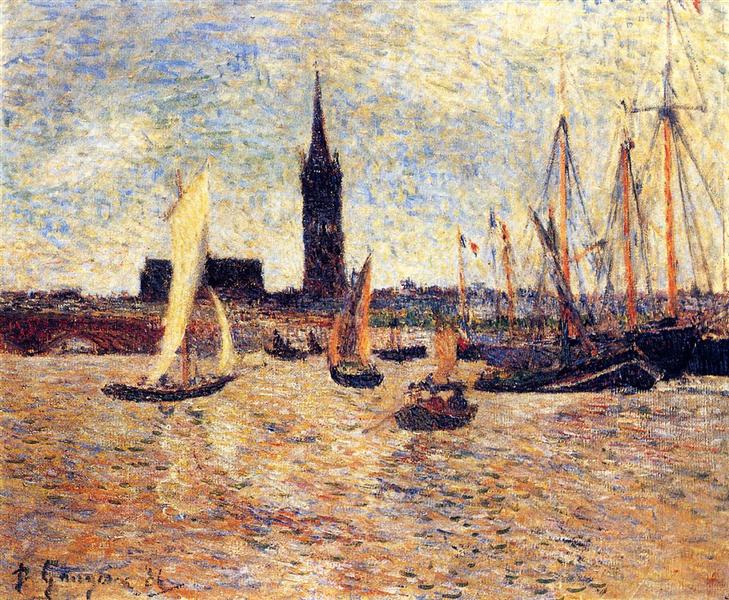Description
Paul Gauguin's painting "Port of Bordeaux" (1886) is a work that encapsulates both the energy of the port and the artist's signature richness of color, a synthesis of his recognition in the context of Post-Impressionist art. Executed at a time when Gauguin was beginning to move away from Impressionism towards a more personal and symbolic style, this work demonstrates a unique approach to capturing light and atmosphere, exploring the interactions between figure and environment.
The composition of the work is dominated by the depiction of the port, with a background featuring a series of anchored boats, with sails and structure visible, creating a visual narrative evoking commercial activities and the hustle and bustle of port life. Gauguin uses vertical lines to guide the eye towards the background of the painting, where the boats are lined up in an almost harmonious order, showing their willingness to interact with the landscape and the water. This use of space is significant, as it not only gives a sense of depth, but also pays homage to the maritime life of Bordeaux, a city of great commercial importance at the time.
Colour, essential in Gauguin’s arsenal, is vibrant and contrasting. Blue and green hues dominate in the water and sky, while earthy and reddish tones bring warmth and richness to the scene. This palette is not just for visual effect, but also suggests an underlying emotionality – a recurring theme in Gauguin’s work, wishing to evoke a sense of place through chromatic expression. In “Port of Bordeaux”, colours are not merely representational; they become a vehicle for feeling, a connection between the viewer and the life of the city.
Although the painting shows a certain absence of individual characters in the foreground, it suggests the presence of everyday life through the boats and the activity of the port. This decision by Gauguin to minimize the human figure contrasts with the tendency of other contemporaries who focused more on the narrative through the characters. Instead, Gauguin seems to want to explore the relationship between humanity and the environment, presenting the port as a space where life develops without the need for the intervention of the human figure.
The port environment, with its almost static atmosphere, raises questions about the change and modernity that were beginning to affect many European cities in the 19th century. From his perspective in Bordeaux, Gauguin observes and documents a world in transition. This social and economic context, often ignored in the analysis of his work, highlights Bordeaux's role not only as a port, but also as a symbol of the intersection between tradition and innovation.
"Port of Bordeaux" represents a turning point in Gauguin's career, a moment when he begins to establish a voice of his own characterized by the bold use of color and form, anticipating his later exploration of more spiritual and symbolic themes in his future works. The work may be contemporary with other seascapes of the period, but the unique sensibility Gauguin deploys here establishes a personal connection with the viewer, revealing not only a place, but also the essence of life itself that flows through it.
Through Port of Bordeaux, we can glimpse the path that Gauguin would take in later years, a journey towards self-expression and the search for a new artistic truth that would continue to challenge the conventions of art in his time. Without a doubt, this work remains a testament to the deep connection that Gauguin had developed with his surroundings, an exceptional reflection of his ability to transform the everyday into the extraordinary.
KUADROS ©, a famous painting on your wall.
Hand-made oil painting reproductions, with the quality of professional artists and the distinctive seal of KUADROS ©.
Painting reproduction service with satisfaction guarantee. If you are not completely satisfied with the replica of your painting, we will refund 100% of your money.

